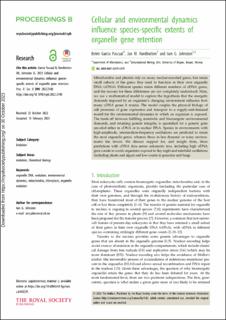Cellular and environmental dynamics influence species-specific extents of organelle gene retention
Journal article, Peer reviewed
Published version

Åpne
Permanent lenke
https://hdl.handle.net/11250/3111847Utgivelsesdato
2023Metadata
Vis full innførselSamlinger
- Department of Mathematics [932]
- Registrations from Cristin [9489]
Originalversjon
Proceedings of the Royal Society of London. Biological Sciences. 2023, 290 (1994), 20222140. 10.1098/rspb.2022.2140Sammendrag
Mitochondria and plastids rely on many nuclear-encoded genes, but retain small subsets of the genes they need to function in their own organelle DNA (oDNA). Different species retain different numbers of oDNA genes, and the reasons for these differences are not completely understood. Here, we use a mathematical model to explore the hypothesis that the energetic demands imposed by an organism’s changing environment influence how many oDNA genes it retains. The model couples the physical biology of cell processes of gene expression and transport to a supply-and-demand model for the environmental dynamics to which an organism is exposed. The trade-off between fulfilling metabolic and bioenergetic environmental demands, and retaining genetic integrity, is quantified for a generic gene encoded either in oDNA or in nuclear DNA. Species in environments with high-amplitude, intermediate-frequency oscillations are predicted to retain the most organelle genes, whereas those in less dynamic or noisy environments the fewest. We discuss support for, and insight from, these predictions with oDNA data across eukaryotic taxa, including high oDNA gene counts in sessile organisms exposed to day-night and intertidal oscillations (including plants and algae) and low counts in parasites and fungi.
